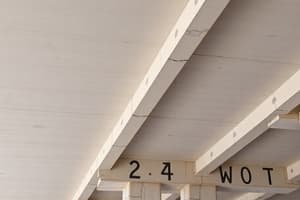Podcast
Questions and Answers
It is used for very large concrete structures. TYPE ___ - A cement used for concretes that are to be exposed to high concentrations of sulfate.
It is used for very large concrete structures. TYPE ___ - A cement used for concretes that are to be exposed to high concentrations of sulfate.
V
Shrinkage Microcracks - initial shrinkage cracks due to carbonation shrinkage, hydration shrinkage, and drying shrinkage. 2. Bond Microcracks – extensions of shrinkage microcracks, as the compression stress field increases, the shrinkage microcracks widen but do not propagate into the ________.
Shrinkage Microcracks - initial shrinkage cracks due to carbonation shrinkage, hydration shrinkage, and drying shrinkage. 2. Bond Microcracks – extensions of shrinkage microcracks, as the compression stress field increases, the shrinkage microcracks widen but do not propagate into the ________.
matrix
Matrix Microcracks - start bridging one another at 75%. Aggregate microcracks occur just before failure (90%). propagate from 20% fc. Occur up to 30-45 % ultimate strength of concrete. Microcracks that occur in the ________.
Matrix Microcracks - start bridging one another at 75%. Aggregate microcracks occur just before failure (90%). propagate from 20% fc. Occur up to 30-45 % ultimate strength of concrete. Microcracks that occur in the ________.
matrix
When mixed with water, cement hardens through a process called ________.
When mixed with water, cement hardens through a process called ________.
Corresponds to secant modulus at 0.45 f’ c. Concrete tested after ___ days to test for strength, _____.
Corresponds to secant modulus at 0.45 f’ c. Concrete tested after ___ days to test for strength, _____.
Concrete tested after 28 days to test for strength, _______.
Concrete tested after 28 days to test for strength, _______.
Instead of rolled-on deformations, __________ has indentations pressed into it.
Instead of rolled-on deformations, __________ has indentations pressed into it.
__________ are not used very often except for wrapping around longitudinal bars, primarily in columns.
__________ are not used very often except for wrapping around longitudinal bars, primarily in columns.
Reinforcing bars may be rolled from ______, ____, or ____. Reinforcing bars deformed bars deformed wire.
Reinforcing bars may be rolled from ______, ____, or ____. Reinforcing bars deformed bars deformed wire.
Identifying Marks on Reinforcing Bars ASTM A615: These bars, which must be marked with the letter S are the most widely used reinforcing bars. Bars are of four minimum yield strength levels: G40, G60, G75, G80. ASTM A706: These bars, which must be marked with the letter W are to be used where controlled tensile properties and/or specially controlled chemical composition is required for welding purposes. G60, G80 ASTM A996: marked with the letter R NATIONAL STRUCTURAL CODE OF THE PHILIPPINES (NSCP) VOLUME I - Volume of NSCP used for design of Building, Towers and other Vertical Structures VOLUME II - Volume of NSCP used for design of Roads, Highways and Bridges 2.
Identifying Marks on Reinforcing Bars ASTM A615: These bars, which must be marked with the letter S are the most widely used reinforcing bars. Bars are of four minimum yield strength levels: G40, G60, G75, G80. ASTM A706: These bars, which must be marked with the letter W are to be used where controlled tensile properties and/or specially controlled chemical composition is required for welding purposes. G60, G80 ASTM A996: marked with the letter R NATIONAL STRUCTURAL CODE OF THE PHILIPPINES (NSCP) VOLUME I - Volume of NSCP used for design of Building, Towers and other Vertical Structures VOLUME II - Volume of NSCP used for design of Roads, Highways and Bridges 2.
Bars are of four minimum yield strength levels: G40, ______, G75, G80. ASTM A706: These bars, which must be marked with the letter W are to be used where controlled tensile properties and/or specially controlled chemical composition is required for welding purposes. ______, G80 ASTM A996: marked with the letter R NATIONAL STRUCTURAL CODE OF THE PHILIPPINES (NSCP) VOLUME I - Volume of NSCP used for design of Building, Towers and other Vertical Structures VOLUME II - Volume of NSCP used for design of Roads, Highways and Bridges 2.
Bars are of four minimum yield strength levels: G40, ______, G75, G80. ASTM A706: These bars, which must be marked with the letter W are to be used where controlled tensile properties and/or specially controlled chemical composition is required for welding purposes. ______, G80 ASTM A996: marked with the letter R NATIONAL STRUCTURAL CODE OF THE PHILIPPINES (NSCP) VOLUME I - Volume of NSCP used for design of Building, Towers and other Vertical Structures VOLUME II - Volume of NSCP used for design of Roads, Highways and Bridges 2.
Reinforcing bars deformed bars deformed wire. Plain bars billet steel, axle steel, ______ Identifying Marks on Reinforcing Bars ASTM A615: These bars, which must be marked with the letter S are the most widely used reinforcing bars.
Reinforcing bars deformed bars deformed wire. Plain bars billet steel, axle steel, ______ Identifying Marks on Reinforcing Bars ASTM A615: These bars, which must be marked with the letter S are the most widely used reinforcing bars.
This load is DESIGN called the factored load or factored service load METHOD or Ultimate Strength Design Dead and Live Load Factored Load U = 1.4 DL combinations U = 1.4 DL + 1.7 LL (ACI 9.2.1) for required Dead, Live, and Wind Loads U = 0.9 DL ± 1.3 WL U = 0.75 (1.4 DL + 1.7 LL ± 1.7 WL) (ACI 9.2.2) Dead, Live, and Earthquake Loads U = 0.9 DL ± 1.3 * 1.1 EL U = 0.75 (1.4 DL + 1.7 LL ± 1.7 * 1.1 EL) (ACI 9.2.3) strength (u) ACI 318-99 Factored Load combinations for required strength U ACI 318-14 Factored Load combinations for required strength (u) NSCP 2015 Load Combination and Safety Factor for WSD overload factor due to probable variation of service loads load specified by general building code (unfactored) 1.has considerable compressive strength per unit cost compared with most other materials. 2.has great resistance to the actions of fire and water. 3.best structural material available for situations where water is present. 4.During fires of average intensity, members with a satisfactory cover of concrete over the reinforcing bars suffer only surface damage without failure. 5.Reinforced concrete structures are very rigid. 6.low-maintenance material. 7.has a very long service life. 8.Under proper conditions, reinforced concrete structures can be used indefinitely without reduction of their load- carrying abilities. 9.strength of concrete does not decrease with time but actually increases over a very long period. 10.
This load is DESIGN called the factored load or factored service load METHOD or Ultimate Strength Design Dead and Live Load Factored Load U = 1.4 DL combinations U = 1.4 DL + 1.7 LL (ACI 9.2.1) for required Dead, Live, and Wind Loads U = 0.9 DL ± 1.3 WL U = 0.75 (1.4 DL + 1.7 LL ± 1.7 WL) (ACI 9.2.2) Dead, Live, and Earthquake Loads U = 0.9 DL ± 1.3 * 1.1 EL U = 0.75 (1.4 DL + 1.7 LL ± 1.7 * 1.1 EL) (ACI 9.2.3) strength (u) ACI 318-99 Factored Load combinations for required strength U ACI 318-14 Factored Load combinations for required strength (u) NSCP 2015 Load Combination and Safety Factor for WSD overload factor due to probable variation of service loads load specified by general building code (unfactored) 1.has considerable compressive strength per unit cost compared with most other materials. 2.has great resistance to the actions of fire and water. 3.best structural material available for situations where water is present. 4.During fires of average intensity, members with a satisfactory cover of concrete over the reinforcing bars suffer only surface damage without failure. 5.Reinforced concrete structures are very rigid. 6.low-maintenance material. 7.has a very long service life. 8.Under proper conditions, reinforced concrete structures can be used indefinitely without reduction of their load- carrying abilities. 9.strength of concrete does not decrease with time but actually increases over a very long period. 10.
Types of cement include Type I, Type II, Type III, Type IV, and ______.
Types of cement include Type I, Type II, Type III, Type IV, and ______.
Microcracks in concrete can occur due to factors like Shrinkage, Bond, and ______.
Microcracks in concrete can occur due to factors like Shrinkage, Bond, and ______.
The hardening process of cement involves the hydration reaction, where cement particles react with water to form a strong ______.
The hardening process of cement involves the hydration reaction, where cement particles react with water to form a strong ______.
Strength testing of concrete can be done through various methods, such as Axial Compression and ______.
Strength testing of concrete can be done through various methods, such as Axial Compression and ______.
Concrete is known for its exceptional durability and ______ properties.
Concrete is known for its exceptional durability and ______ properties.
Flashcards are hidden until you start studying




